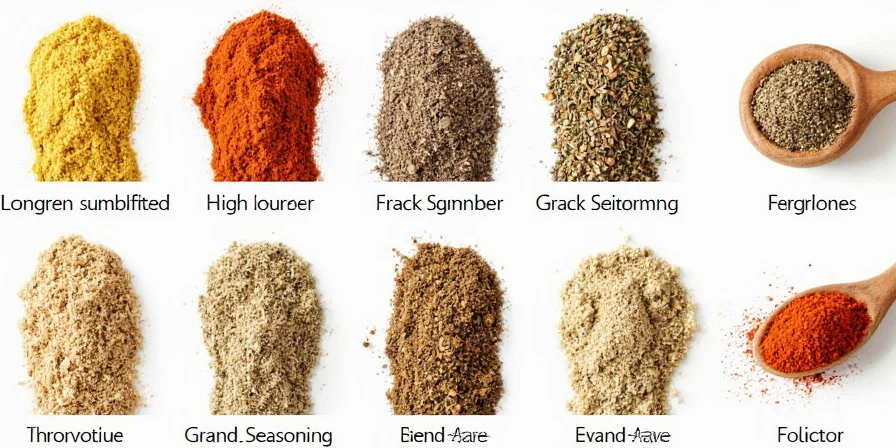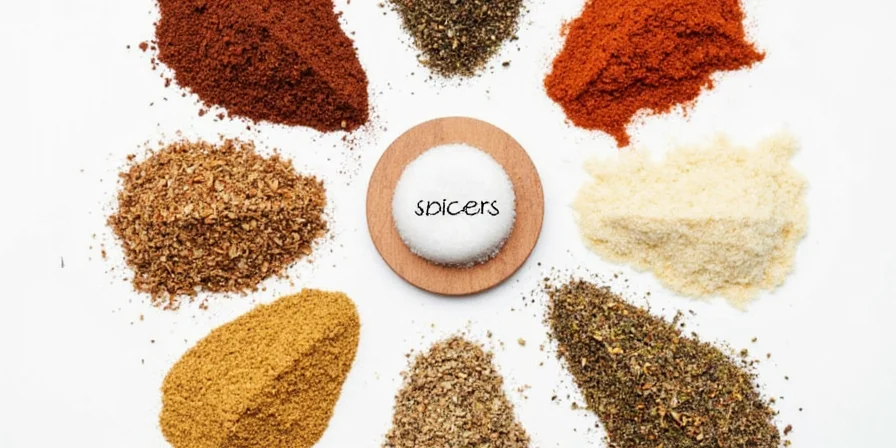The Magic of Salt-Free Seasoning: How to Store and Use It Like a Pro

Imagine this: you're cooking a gourmet meal, and you reach for your trusty salt-free seasoning. But wait—where did you put it? Did you store it in a dark corner of your cabinet, only to find it stale and lifeless when you need it most? Sound familiar? Don’t worry, you’re not alone. In fact, you’re in good company. Professional chefs, home cooks, and flavor enthusiasts all know that the way we store and use our spices can make or break a dish. And when it comes to salt-free seasoning, the stakes are even higher. After all, this isn’t just another spice blend—it’s a flavor powerhouse that can elevate your meals from “meh” to “wow.”
In this article, we’ll dive deep into the world of salt-free seasoning. We’ll explore the key spices that make up this blend, how to store them properly, and the best ways to use them in your cooking. Whether you're a professional chef or a curious home cook, this guide is your go-to resource for maximizing the flavor of your salt-free seasoning.
What Exactly Is Salt-Free Seasoning?
Before we jump into storage and usage hacks, it’s important to understand what exactly salt-free seasoning is. As the name suggests, it’s a blend of herbs and spices that enhances flavor without the use of salt. This makes it a popular choice for people who are watching their sodium intake, or for those who simply want to add more depth of flavor to their dishes without the need for extra salt.
But what spices make up this magical blend? Let’s take a closer look.
Key Spices in Salt-Free Seasoning
- Garlic Powder: Adds a rich, umami flavor that’s essential for many savory dishes.
- Oregano: A Mediterranean favorite that brings a slightly earthy and slightly bitter note to dishes like pasta, pizza, and grilled meats.
- Cumin: Adds a warm, nutty flavor that’s perfect for Mexican, Indian, and Middle Eastern cuisine.
- Black Pepper: Provides a sharp, spicy kick that enhances the depth of flavor in any dish.
- Paprika: Adds a sweet, smoky, or slightly spicy flavor depending on the type used. It’s also a natural color enhancer.
- Onion Powder: Mimics the flavor of fresh onions without the moisture, making it a staple in many seasoning blends.
- Thyme: Offers a subtle, earthy flavor that pairs well with a wide variety of dishes.
- Rosemary: Adds a piney, aromatic flavor that’s perfect for roasted meats and vegetables.
These spices, when combined, create a versatile seasoning blend that can be used in everything from soups and stews to meats and vegetables. But for this blend to truly shine, you need to store and use it correctly. Let’s explore how to do that.
Pro Tips for Storing Salt-Free Seasoning
Proper storage is key to keeping your salt-free seasoning fresh and flavorful. Here are some expert-level tips to help you keep your spices in top condition:
1. Keep It Cool and Dark
Heat and light are the enemies of spices. Exposure to either can cause them to lose their potency and flavor over time. The ideal storage location is a cool, dark place—think a pantry or a cabinet that’s not near the stove or oven.
| Storage Location | Recommended | Not Recommended |
|---|---|---|
| Pantry | ✅ | ❌ |
| Cabinet | ✅ | ❌ |
| Near the stove | ❌ | ✅ |
| Refrigerator | ❌ | ✅ |
As you can see, the pantry and cabinet are the best options. The refrigerator is not ideal for most spices, as the moisture can cause clumping and reduce flavor.
2. Use Airtight Containers
Airtight containers are your best friend when it comes to spice storage. They help keep out moisture, air, and light, all of which can cause your spices to degrade over time. Look for glass jars with tight-fitting lids—these are not only durable but also allow you to see how much you have left.
If you're using plastic containers, make sure they are BPA-free and have a secure seal. Avoid using open jars or containers with loose-fitting lids, as they can allow air and moisture to seep in.
3. Label and Date Your Spices
It’s easy to forget when you last used your salt-free seasoning, especially if you have multiple jars and blends. To avoid using old, stale spices, label each jar with the name of the seasoning and the date it was opened or made. This will help you keep track of freshness and ensure that you’re always using the best-quality product.
4. Avoid Using the Original Container
While it might be tempting to keep your salt-free seasoning in the original container, this is not the best idea. The original packaging is often not airtight, and it can be difficult to see how much seasoning you have left. Invest in a high-quality airtight jar or container instead.
5. Store in Small Quantities
If you're making your own salt-free seasoning blend, it’s best to store it in small quantities. This way, you can use it up before it loses its potency. Large batches can be stored in the freezer for long-term use, but for daily use, small jars are ideal.
Maximizing Flavor: Usage Hacks for Salt-Free Seasoning
Now that we’ve covered how to store your salt-free seasoning, let’s move on to the fun part: using it in your cooking. Here are some pro-level hacks to help you get the most out of this versatile blend.
1. Use It as a Base for Other Flavors
Salt-free seasoning is a great base for other spices and herbs. Think of it as the foundation of a flavor pyramid. You can add additional spices like chili powder, coriander, or turmeric to create a more complex flavor profile.
For example, if you're making a stir-fry, start with a layer of salt-free seasoning, then add a dash of chili powder and a sprinkle of turmeric for extra depth.
2. Use It in Marinades
Salt-free seasoning can be a game-changer in marinades. It adds flavor without the need for salt, making it an excellent choice for those who are watching their sodium intake. Simply mix the seasoning with oil, garlic, and a bit of vinegar or citrus juice for a quick and easy marinade.
Try this simple marinade: 2 tablespoons of olive oil, 1 tablespoon of salt-free seasoning, 1 clove of garlic (minced), and 1 tablespoon of lemon juice. Let your chicken or vegetables sit in this mixture for at least 30 minutes before cooking.
3. Use It in Soups and Stews
Salt-free seasoning is a must-have in any soup or stew. It adds depth of flavor without overpowering the other ingredients. Add a teaspoon or two to your soup or stew early in the cooking process, and let it simmer for a few minutes to allow the flavors to meld together.
For a more intense flavor, you can also add a few drops of liquid smoke or a pinch of smoked paprika to give your soup or stew a smoky undertone.
4. Use It in Baked Goods
Believe it or not, salt-free seasoning can also be used in baked goods. It adds a subtle, savory note that can enhance the flavor of breads, crackers, and even some types of cookies. Just be careful with the amount you use, as too much can make your baked goods taste overly spicy or bitter.
Try adding a teaspoon of salt-free seasoning to your next batch of whole wheat bread or crackers for a unique, savory twist.
5. Use It in Rubs and Sauces
Salt-free seasoning is a great addition to rubs and sauces. It can be mixed with other spices like cayenne pepper, garlic powder, and smoked paprika to create a bold, flavorful rub for meats. For sauces, simply mix the seasoning into a base of olive oil, vinegar, or soy sauce for a quick and easy flavor boost.
Try this simple rub: 2 tablespoons of salt-free seasoning, 1 tablespoon of garlic powder, 1 teaspoon of cayenne pepper, and 1 tablespoon of smoked paprika. Mix well and apply to chicken, pork, or beef before grilling or roasting.
Common Mistakes to Avoid
Even the most experienced cooks can fall into the trap of making common mistakes when it comes to storing and using salt-free seasoning. Here are a few to watch out for:
- Using it too late in the cooking process: Salt-free seasoning should be added early in the cooking process to allow the flavors to develop properly. Adding it at the end can result in a less intense flavor.
- Using it in excess: While salt-free seasoning is flavorful, using too much can overwhelm the other ingredients in your dish. Start with a small amount and adjust to taste.
- Using it in the wrong type of dish: Not all dishes are suitable for salt-free seasoning. For example, it may not be the best choice for desserts or sweet dishes. Use it in savory, umami-rich dishes instead.
- Storing it in the wrong environment: As we’ve already discussed, storing your salt-free seasoning in a hot, humid, or light-filled area can cause it to lose potency and flavor over time.
By avoiding these mistakes, you can ensure that your salt-free seasoning stays fresh and flavorful for longer, and that your dishes come out tasting great every time.
Final Thoughts: Elevate Your Cooking with Salt-Free Seasoning
Salt-free seasoning is more than just a flavor booster—it’s a versatile ingredient that can be used in a wide variety of dishes. Whether you're making a simple stir-fry or a complex stew, this seasoning can help you take your cooking to the next level.
By storing it properly and using it in the right way, you can ensure that your salt-free seasoning stays fresh and flavorful for longer. And with a little practice, you’ll soon be a pro at using this magical blend to create delicious, restaurant-quality meals in your own kitchen.
So go ahead—grab your salt-free seasoning, and start experimenting. You never know what amazing flavors you might discover along the way.

Remember, the key to great cooking is not just the ingredients you use, but how you store and use them. With the right techniques, you can unlock the full potential of your salt-free seasoning and take your cooking to new heights.
Happy cooking, and don’t forget to season wisely!










 浙公网安备
33010002000092号
浙公网安备
33010002000092号 浙B2-20120091-4
浙B2-20120091-4